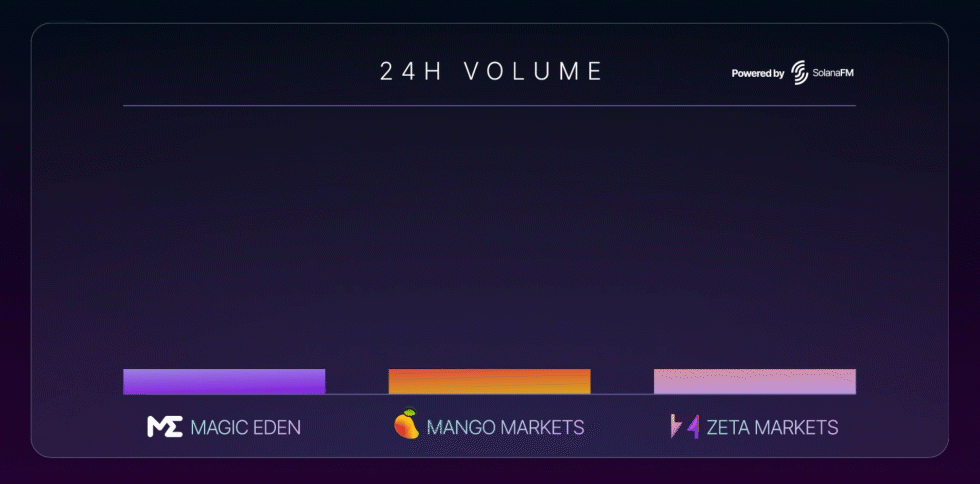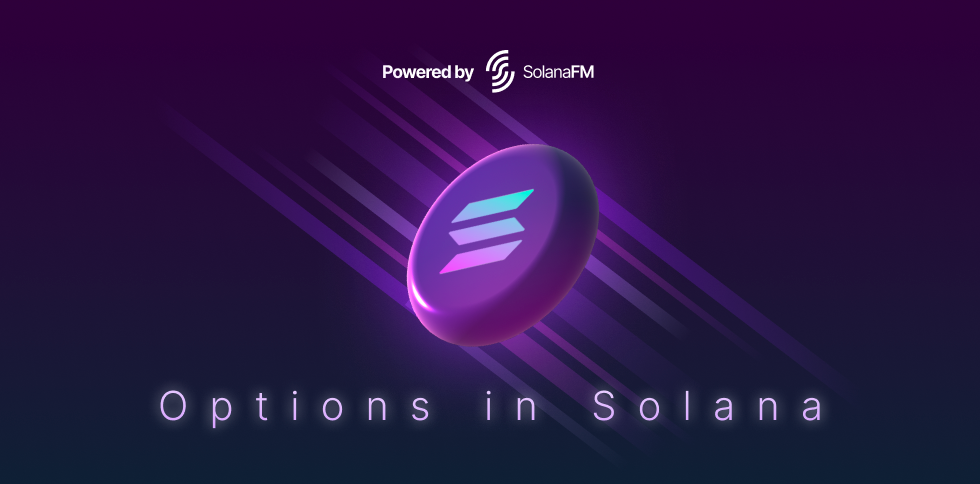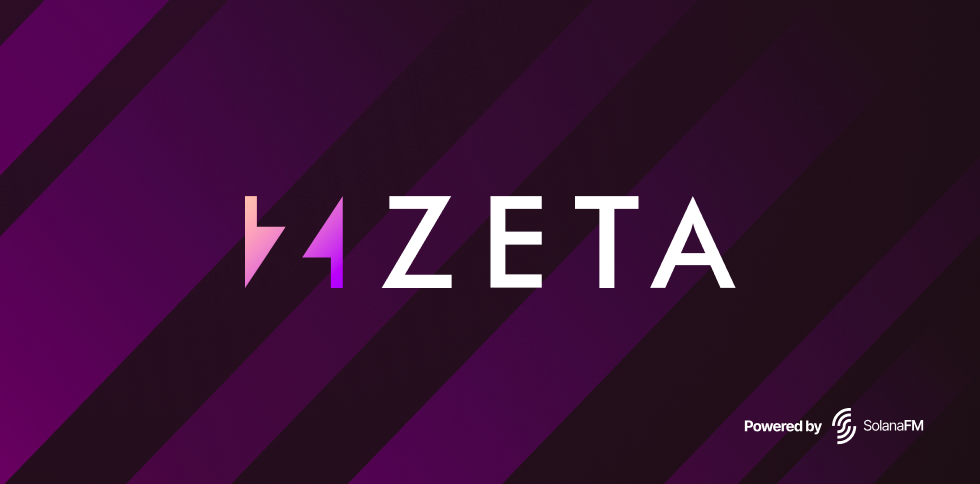What Are The Best Strategies Involving Options in Solana? A Deep Dive with SolanaFM
Introduction
The total crypto market cap has been on an 8-month downtrend, currently sitting at almost 70% below its all-time high. In these market conditions, it is important to venture into strategies that focus on capital preservation. As traders commonly turn to low-leverage trading, buying blue-chip NFTs or yield-farming strategies, little are aware of options as a trading strategy in Solana. At the time of writing (28 June), a rough comparison between the 24-hour volume on Magic Eden (NFT Marketplace), Mango Markets (Trading DEX) and Zeta Markets (Options DEX) shows that majority of trading activity comes from NFT and perpetual trading platforms.
In this report, we will shed light into how options work in Solana, an overview of various options protocols and a few case studies from each protocol. The case studies will dig deeper into how traders use options to profit or to hedge against risk. Before that, a quick primer on options.
How Do Options Work?
Options, by definition, give traders an ‘option’ to buy or sell assets at a certain defined price (called a strike price) by a set expiration date. Options mainly consist of calls and puts, which gives holders the right to buy and sell an asset respectively. To visualise this, here is an example of a call option.
Solana is trading at $50 today. Trader Joe thinks that the price of Solana will go above $100 next month. Today, he pays $5 for an option to buy Solana at $100 next month. In this case, two outcomes may occur — he either exercises the option and buys Solana for a total of $105, or he does not exercise the option and spends a total of $5. If the price of Solana next month ends up being $150, Trader Joe can exercise his option and buy Solana at a cost to date of $105, instantly reaping $45 in profit. However, if the price of Solana next month ends dipping to $50, there is no need for him to exercise his option and his cost to date would only be $5.
From the example, we can see that options provide traders with an opportunity to trade assets with unlimited upside (in this example, $45 profit), while also limiting the downside (in this example, $5 loss). If deployed properly, options can be traded alongside other strategies (e.g. trading perpetuals) as a way to reduce portfolio risk.
With that, let us explore a few platforms that offer options trading on Solana.
Introduction to Options in Solana
In the Solana ecosystem, different platforms have unique strategies to generate profits by utilizing options contracts. In this report, we will zoom into three extensive protocols: Zeta Markets, PsyFinance and Friktion.
Zeta Markets
Zeta Markets is a derivatives protocol with an under-collateralized Options & Futures trading DEX. This means the platform requires significantly lesser collateral as options are less risky compared to when used standalone. Zeta allows traders to buy and sell options & futures via orderbook-style bids and asks.

Based on the figure above, we can see that the current expiry dates for SOL calls are 1st July and 8th July with strike prices ranging from $63 to $24. These expiry dates and strike prices are updated regularly based on the Options Contract Specification Schema.
PsyFinance
PsyFinance works slightly differently compared to Zeta Markets — the protocol focuses on yield generation instead of directly trading options contracts. Unlike other yield-generating vaults, PsyFinance offers yield through the execution of option strategies generated via the protocol.

Based on the figure above, PsyFinance operates two main types of vaults; Covered Call vaults and Put Selling vaults. These are common options strategies — Put Selling vaults are designed to generate yield on stables in sideways/bull markets, while Covered Call selling vaults are designed to generate yield while maintaining a long position on an asset. We will focus on the SOL Covered Call vault for analysis in the next section.
Friktion
Friktion is a portfolio management protocol offering four ‘Volts’ which which are strategies that generate passive returns based on the trader’s risk appetite — similar to the strategies offered on PsyFinance.
Friktion’s Volts include Covered Call and Put Selling strategies on top of additional delta-neutral strategies. For analysis, we will focus on Volt #02, namely the SOL Put Selling Volt.
Investigating Option Strategies in Solana
Now that we have covered the various protocols involving option strategies, onto the main question — what are the best option strategies in Solana?
We will use SolanaFM’s explorer to trace the wallets of the top earners in Zeta Markets as well as the accounts with the largest deposits into the PsyFinance and Friktion vaults, looking out for any strategies being deployed to profit or to manage portfolio risk.
Case Study 1: Zeta Markets

In this case study, we identified the account with the largest increase in true PnL (1uck..cDmJ) over the last 10 days (17 June to 27 June) and traced its the wallet’s recent activity.

Based on Zeta Markets’ on-chain analytics, this account made over 100 trades over the period. Only small proportion of the trades were contracts that had been exercised for profit — instead, a large majority of the trader’s profits were by selling call options.

Let us visualise this strategy. The figure above shows SOL currently at $32.25. Call options with a strike price of $63 and an expiry date of 8 July are available for trading. If a trader believes that the price of SOL will not surge above $63, they can sell call options and pocket the premiums if the options are not exercised by the expiry date.
In the case of 1ucky…DmJ, the trader managed to earn an average of $500 in premiums by selling call options that they believed would expire out of the money.
Would the trader be better off holding SOL in spot? Over the period of 17 June to 27 June, the price of SOL rose over 25% from $30 to about $38.4. Given that each trade has an average notional size of $50,000, this would amount to a $12,500 rise in value if the trader held SOL in spot instead.
In this case, option trading has proved to be much more profitable for the trader. However, this strategy involves a substantial risk — if the price of SOL skyrockets above $63 and the buyer exercises their option, the seller will be the one incurring the costs. As much as selling call options may be a profitable strategy, it should not be done in volatile markets with large movements.
Case Study 2: PsyFinance
Based on PsyFinance’s on-chain analytics, we retrieved the top accounts holding the SOL Covered Call Vault token and identified a wallet which appears to be actively tracking and shifting funds between platforms with the highest yields possible.

Based on the figure above, we can see that the trader deposited USDT into Solend Protocol’s Main Pool Vault for a short span of two days before withdrawing the funds.
We delved further and realized that this transfer was made in the midst of a large withdrawal of funds from Solend Protocol’s Main Pool, causing the lending APY of USDT to skyrocket upwards of 367% for a brief period.

This was most likely why the trader supplied funds to Solend for the short period, where the lending APY stabilized afterwards. From the two days alone, they would have successfully made a 2% scalp. The trader subsequently made a transfer into PsyFinance’s SOL Call Vault three days later.

At the time of writing, PsyFinance’s SOL Call Vault provides a 88.79% APY. However, Covered Call options favour the downside in order to prevent hitting the strike price as shown in the figure below.

In this case, if the price of SOL goes above the strike price of $52 and the option is exercised, the trader may incur losses instead. This could be another yield scalp, or they possibly have conviction in downward price action in the near future.
Although scalping short-term yields appears to be a low-risk method to earn profit, this strategy may be troublesome as it requires the trader to be constantly updated with the latest APY rates across several protocols. Additionally, the strategy does not rule out any impermanent losses if SOL’s price falls.
Would the trader be better off holding SOL in spot? The price of SOL from 15 June to the time of writing was $34.60 and $35.20 respectively — over the period, SOL saw volatile downward and upward price movements and ended up with a mere 1.55% profit. In this case, yield scalping was a good move for this trader.
Case Study 3: Friktion
In the case of Friktion, we have an example of a trader practicing portfolio risk management — a wallet that holds assets on both Friktion Volt #01 (Covered Call) and Volt #02 (Secured Puts).

Based on the figure above, we can see that the latest transaction of the wallet was in April 2022. Upon further inspection, we found that the trader began accumulating their position back in January 2022.

Based on the figure above, the largest position in the trader’s portfolio is worth $88,000, or 125,130 fpSOL — the token of Friktion’s Secured Put Vault. This vault favours upward price action, lowering the chances of the options being exercised.

However, other assets in the wallet include fcSOL and fcmSOL, which are the the tokens of Friktion’s Covered Call vaults for SOL and mSOL. Additionally, the trader holds kcSOL, which are tokens of Katana’s SOL Covered Call Vault.
Though the large position in the Put Vault shows that the trader may have strong conviction in upward price action, the smaller yet significant positions in the various Call Vaults (favouring downside) show some form of de-risking.
Would the trader be better off holding SOL in spot? Throughout the period, the price of SOL collapsed 80% from $179 to $34.50. In this case, trader would have incurred impermanent losses from the Secured Put vaults if the options were exercised below strike price. However, the existing positions in the Call vaults would have slightly cushioned the trader’s losses — it would still be much safer than holding SOL in spot.
The Bottom Line
Going back to the initial question — how profitable are strategies covered? Can the average Joe replicate these strategies?
With these case studies in mind, we must note that the performance of these strategies largely depends on the movement of the asset. Vaults deploying the Covered Call and Secured Put strategies reward traders as long as the market does not see drastic upward or downward price movements; On the other hand, large price movements may reward traders who exercise call and put options directly.
From a general standpoint, we can see that anyone can replicate these option strategies and they may be useful in managing our portfolio’s risk. Nonetheless, be sure to DYOR before embarking on any investment strategies.
Appendix
Zeta Markets: https://mainnet.zeta.markets/
PsyFinance: https://www.psyfi.io/vaults
Friktion: https://friktion.fi/
Zeta Markets Options Contract Specification Schema: https://zetamarkets.gitbook.io/zeta/zeta-protocol/derivatives-framework/options-contract-specifications
Case Study 1 - Zeta Markets trader wallet: https://solana.fm/address/1ucky6S59JdQTFMgGERbxxHxfpXgmo4Uz6DpXjGcDmJ
Case Study 2 - PsyFinance trader wallet history: https://solana.fm/address/398v8A72s5q9oJJzVbZWSbGu5kkcvq6Pc79FcTa7K3xK
Solend Protocol: https://solend.fi/dashboard
Case Study 2 - Fund movements into the PsyFinance SOL Call Vault: https://solana.fm/tx/5AmseXEPHgLZP6374XhW6VfzS57wectx3XaFyXTpsuPSpvJKtrMEekv1N23XGf52tYoGvyTZ6M85q4QbpPF2R1RB
Case Study 3 - Transaction history of Friktion trader wallet: https://solana.fm/address/Cr8yD1S3xz4hKxgRbzYt7v3rqwZPFquhYjGVmzntRi7U
Case Study 3 - Asset breakdown of Friktion trader’s wallet: https://solana.fm/address/Cr8yD1S3xz4hKxgRbzYt7v3rqwZPFquhYjGVmzntRi7U












